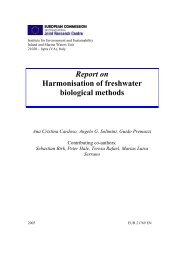Lakes and Watercourses
Lakes and Watercourses
Lakes and Watercourses
You also want an ePaper? Increase the reach of your titles
YUMPU automatically turns print PDFs into web optimized ePapers that Google loves.
(in Swedish with English summary). The method of identifying reference<br />
values is explained in each chapter. In general, it may be said that further<br />
systematic studies are needed for most parameters in order to obtain<br />
representative data.<br />
It was proposed in the previous quality criteria for lakes <strong>and</strong> watercourses<br />
(Swedish EPA 1991) that county administrative boards <strong>and</strong><br />
water management associations should compile maps on background<br />
conditions by catchment based on results from earlier surveys <strong>and</strong> studies<br />
of unaffected lakes <strong>and</strong> watercourses or using specified calculation algorithms.<br />
This is still to be recommended <strong>and</strong> would probably allow better<br />
adjustment to local or regional conditions than direct application of the<br />
reference values presented here, which are often regional <strong>and</strong> statistically<br />
based.<br />
Division in type areas<br />
Since available data varies greatly from one parameter to another <strong>and</strong><br />
since various surrounding factors are significant to each parameter, it has<br />
not been possible to classify geographical regions <strong>and</strong> water types on the<br />
basis of principles common to all parameters. The various classifications<br />
are described in each chapter.<br />
References<br />
Swedish Environmental Protection Agency (1991): Bedömningsgrunder<br />
för sjöar och vattendrag (”Quality criteria for lakes <strong>and</strong> watercourses”).<br />
Swedish EPA General Guidelines 90:4.<br />
18















![Accommodation booking form [PDF]](https://img.yumpu.com/39471785/1/184x260/accommodation-booking-form-pdf.jpg?quality=85)

